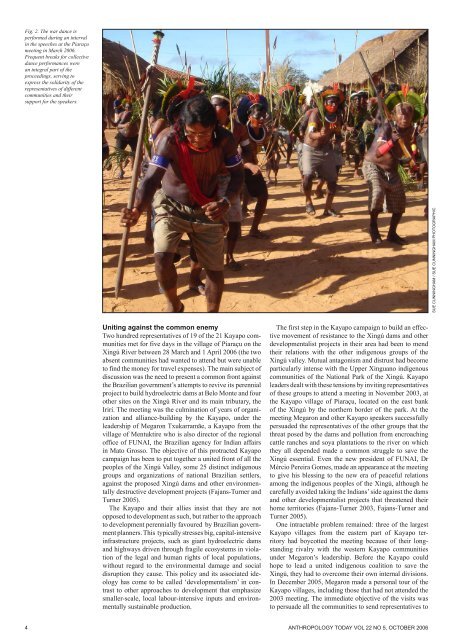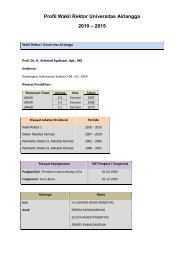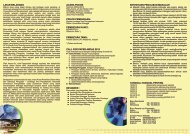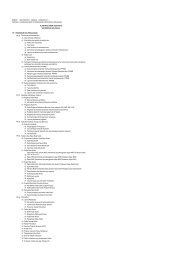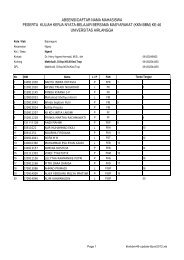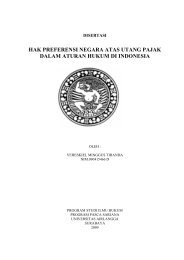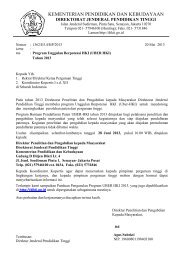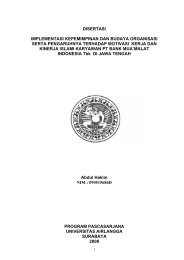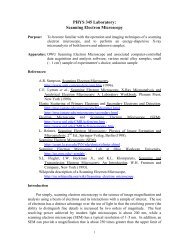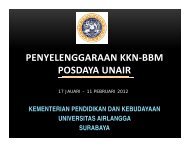View - UNAIR | E-Book Collection
View - UNAIR | E-Book Collection
View - UNAIR | E-Book Collection
You also want an ePaper? Increase the reach of your titles
YUMPU automatically turns print PDFs into web optimized ePapers that Google loves.
Fig. 2. The war dance isperformed during an intervalin the speeches at the Piaraçumeeting in March 2006.Frequent breaks for collectivedance performances werean integral part of theproceedings, serving toexpress the solidarity of therepresentatives of differentcommunities and theirsupport for the speakers.Sue Cunningham / Sue Cunningham PhotographicUniting against the common enemyTwo hundred representatives of 19 of the 21 Kayapo communitiesmet for five days in the village of Piaraçu on theXingú River between 28 March and 1 April 2006 (the twoabsent communities had wanted to attend but were unableto find the money for travel expenses). The main subject ofdiscussion was the need to present a common front againstthe Brazilian government’s attempts to revive its perennialproject to build hydroelectric dams at Belo Monte and fourother sites on the Xingú River and its main tributary, theIrirí. The meeting was the culmination of years of organizationand alliance-building by the Kayapo, under theleadership of Megaron Txukarramãe, a Kayapo from thevillage of Mentuktire who is also director of the regionaloffice of FUNAI, the Brazilian agency for Indian affairsin Mato Grosso. The objective of this protracted Kayapocampaign has been to put together a united front of all thepeoples of the Xingú Valley, some 25 distinct indigenousgroups and organizations of national Brazilian settlers,against the proposed Xingú dams and other environmentallydestructive development projects (Fajans-Turner andTurner 2005).The Kayapo and their allies insist that they are notopposed to development as such, but rather to the approachto development perennially favoured by Brazilian governmentplanners. This typically stresses big, capital-intensiveinfrastructure projects, such as giant hydroelectric damsand highways driven through fragile ecosystems in violationof the legal and human rights of local populations,without regard to the environmental damage and socialdisruption they cause. This policy and its associated ideologyhas come to be called ‘developmentalism’ in contrastto other approaches to development that emphasizesmaller-scale, local labour-intensive inputs and environmentallysustainable production.The first step in the Kayapo campaign to build an effectivemovement of resistance to the Xingú dams and otherdevelopmentalist projects in their area had been to mendtheir relations with the other indigenous groups of theXingú valley. Mutual antagonism and distrust had becomeparticularly intense with the Upper Xinguano indigenouscommunities of the National Park of the Xingú. Kayapoleaders dealt with these tensions by inviting representativesof these groups to attend a meeting in November 2003, atthe Kayapo village of Piaraçu, located on the east bankof the Xingú by the northern border of the park. At themeeting Megaron and other Kayapo speakers successfullypersuaded the representatives of the other groups that thethreat posed by the dams and pollution from encroachingcattle ranches and soya plantations to the river on whichthey all depended made a common struggle to save theXingú essential. Even the new president of FUNAI, DrMércio Pereira Gomes, made an appearance at the meetingto give his blessing to the new era of peaceful relationsamong the indigenous peoples of the Xingú, although hecarefully avoided taking the Indians’ side against the damsand other developmentalist projects that threatened theirhome territories (Fajans-Turner 2003, Fajans-Turner andTurner 2005).One intractable problem remained: three of the largestKayapo villages from the eastern part of Kayapo territoryhad boycotted the meeting because of their longstandingrivalry with the western Kayapo communitiesunder Megaron’s leadership. Before the Kayapo couldhope to lead a united indigenous coalition to save theXingú, they had to overcome their own internal divisions.In December 2005, Megaron made a personal tour of theKayapo villages, including those that had not attended the2003 meeting. The immediate objective of the visits wasto persuade all the communities to send representatives to ANTHROPOLOGY TODAY Vol 22 No 5, October 2006


